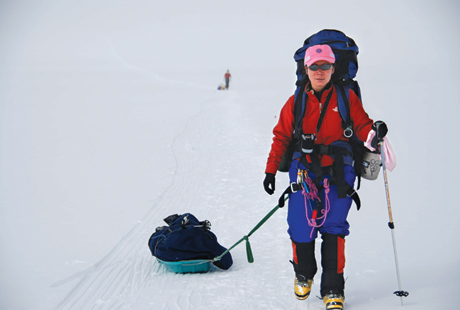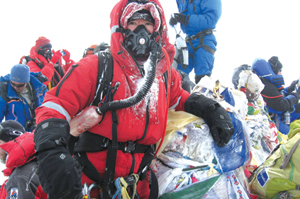 |
Large Medium Small |
|
 Wang Lei in Antarctica in 2008. The trekking through endless stretches of snow is mentally draining, she says. Photos Provided to China Daily |
A Beijing native has become the first Chinese woman to scale the summits of the world's tallest mountains, completing mountaineering's ultimate 'Seven Plus Two' challenge, reports Karyn Piechule
In May, after reaching the summit of Mt Qomolangma, Beijing-native Wang Lei became the first Chinese woman to complete the ultimate mountaineering "Seven Plus Two" challenge.
| ||||
Wang, now 38, has returned to China motivated and determined to help others "live with a passion."
Growing up in Haidian district, Wang was not athletically inclined, as she spent most of her time studying. But while working on her MBA at the Wharton School, in the United States, she signed up for an opportunity that would change the course of her life.
During the winter break of 2002, a teamwork and leadership training program was offered to students, which sent them to Mt Cotopaxi in Ecuador. The nearly 6,000-meter mountain would be Wang's first climb.
"It was the first time I'd even seen a mountain covered in snow," Wang says. "Even the word 'mountaineering' was foreign to me."
Cotopaxi, recognized as a good beginner mountain, proved to be difficult for Wang. She was tired, cold, and had no sense of pacing, a skill necessary to stay efficient while climbing at high altitudes. But after reaching the summit, Wang felt a great sense of achievement.
"It opened the door for me. I still didn't think that in the future I would do anything related to mountaineering but it improved my self-confidence, made me more positive," she says.
Upon graduating from Wharton in 2003, Wang and four other classmates signed up for a trip to Kenya and Tanzania. After safari tours, and sight-seeing, it was Wang who suggested that the group should climb the 5,895 meter Mt Kilimanjaro.
"I was still not thinking about anything related to the sport," she says. "But how can you go Africa without going to see Kilimanjaro."
The five-day hike was difficult, proving to Wang how physically out of shape she was. Again, she reached the summit, tired and weak, but was overwhelmed by how mentally positive she felt about the experience.
"I was very unfit and I really did not think I could make the summit," Wang says. "But every time I did something that appeared impossible, I learned to think of it as a possibility. That confidence grew stronger with each mountain."
What started as a recreational trip through school sparked an interest in Wang that she could not ignore. Once home, she found herself scouring the shelves of the Boston Public Library for information on the most legendary mountain of all, Mt Qomolangma, also known as Mt Everest in the West.
|
 Wang at the Qomolangma summit. Euphoria soon gave way to anxiety about the treacherous way down.
|
"The more you do it, the more you like it. I really wanted to finish this, that's what kept me going," she says.
And so in June of 2004, Wang set herself the goal of climbing the Seven Summits - which include Aconcagua (South America), Carstensz Pyramid (Australia), Denali (North America), Kilimanjaro (Africa), Elbrus (Europe), Vinson (Antarctica), and Qomolangma (Asia) - and skiing to the North and South Poles.
With the plan to save the 8,848-meter Mt Qomolangma for last, Wang spent years climbing the other six locations and skiing the two poles. She learned important skills, trained rigorously, and dedicated her time, and money, to completing the goal.
It was at Elbrus in 2005 that she faced the harshest weather, where many of the climbers got frostbite by the time the climb was over. At Aconcagua three years later, she faced low blood oxygen levels and had trouble breathing. In 2008, while at the South Pole mental frustration set in. There is no sense of time and hiking with a 45-kilogram sled attached to her, the monotonous, white barren land made the trek mentally draining.
After the six mountains and two poles were complete, she hired a personal trainer and spent months lifting weights and running marathons in order to get ready for the two-month Qomolangma expedition.
"I was never sure if I could do it," Wang says. "I never thought I could be strong enough or train well enough. My trainer pushed me to the point where he didn't break me, but made me stronger."
In March this year, Wang was ready. Along with 26 other climbers, three American guides and individual Sherpas for each climber, the group began their journey.
Throughout the climb, many negative challenges faced the climbers. Sleeping at the camps was uncomfortable and the food never seemed to be nutritious enough to recover valuable strength. Temperatures would fluctuate from freezing cold to burning hot when the sun would come out. Even the pressure to complete the daunting task became emotionally and mentally taxing for some.
Nine climbers dropped out during various points of the hike but Wang stayed.
Closer to the summit, where temperatures drop to -26 C, Wang says she never felt overly cold because of all the layers she wore. However, when she stopped walking she could feel her fingers and toes freezing. No part of the body was to be exposed and climbers were warned not to take their goggles off because of fear their corneas would freeze in the frigid temperatures.
When the group reached the summit, Wang recalls members of the group hugging, congratulating one another, and taking photos. But, the celebration was short-lived.
"I had relief knowing that I had reached this goal, but then you become more concerned that you have to get back down," she says.
Reaching the end of the journey, the only thing Wang desired was sleep.
After facing Mt Qomolangma, along with the rest of the Seven Summits and two poles, Wang has since moved on to another adventure, inspiring and motivating people to achieve their own personal goals.
"I am looking for a business model where I can motivate more people to pursue their dream. I want to do something more meaningful as a career," she says.